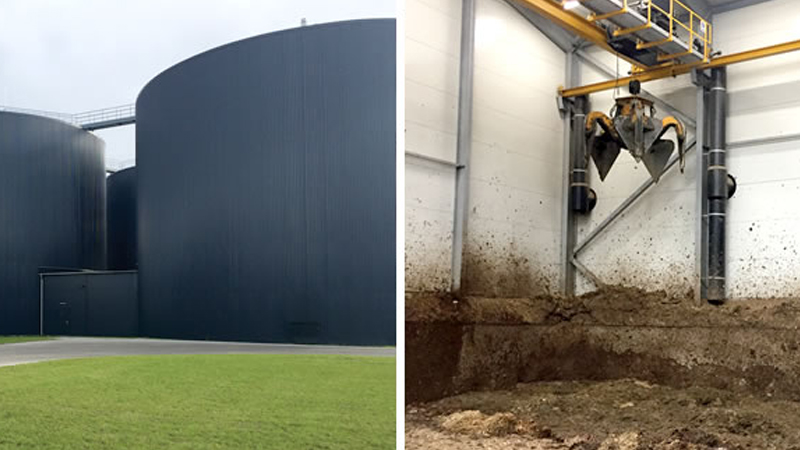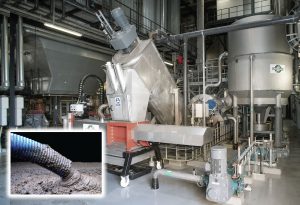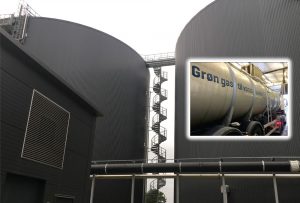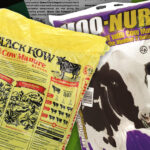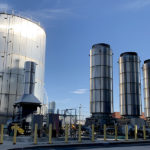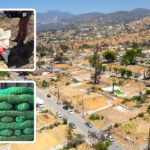Louise Hansen, Robert Spencer and Tony Barbagallo

Biogas became a political priority in Denmark as a means to control agricultural waste management problems and provide a flexible renewable energy product. (Photo on left, taken at Nature Energy Månsson biogas plant in Brande.) Receiving hall for deep litter (non-liquid manure) at the Midtfyn Biogas Plant (right).
In September 2018, a diverse group of 13 professionals from the U.S. biogas sector traveled to Denmark to learn about policies and innovations related to development and operation of biogas systems. The four-day trip (see sidebars for itinerary and U.S. participants) was organized by the Danish Trade Council, and included meetings with policy makers, and tours of biogas plants, associated gas treatment and odor control systems, and food waste preprocessing facilities.
Denmark is well known as a world leader in its endeavors to create a circular and green economy. The study tour demonstrated a significant national commitment to the development of biogas, as well as collaboration between private companies and universities. The state of biogas in Denmark has been driven by economies of scale, standardized designs, buy-in from farmers and, not least, strong, bipartisan policy support.
U.S. Delegation
-

U.S. delegation of biogas sector professionals
Kevin Abernathy, California (CA) Milk Producers Council
- Tony Barbagallo, Casella Organics
- Kelliann Blazek, Staff Counsel, Congresswoman Chellie Pingree
- Morgan Casella, Dynamic Organics
- Liza Frazer, CA Milk Producers Council
- Geetika Joshi, CA Department of Food and Agriculture
- Deep Kolhatkar, Tulum Trust
- Jim Lucas, Southern California Gas Co.
- Tim Olson, CA Energy Commission
- Christine Polo, Black & Veatch
- Robert Spencer, BioCycle and Windham Solid Waste Management District
- Chris Voell, The Trade Council N. America of Denmark (formerly with AgSTAR when on trip)
- Rob Williams, University of CA Davis
Waste Management Evolution
The oil crisis in the 1970s and 1980s made energy security a political priority for the Danish government. Denmark started to invest in oil and natural gas exploration in the North Sea, but due to limited natural resources, there was also a significant push for exploring alternative means of energy.
Denmark consists of several islands, with favorable winds making wind power a good investment. In 2017, 43.2 percent of Denmark’s power production was derived from wind. Its economy has remained robust during the past 38 years of investing in renewable energy, growing by more than 70 percent since 1980, while holding energy consumption at the 1980 level.
For over 100 years, Denmark has incinerated a large portion of its solid waste in municipally owned waste-to-energy (WTE), combined heat and power (CHP) plants. The Danish government considers WTE to be renewable biomass energy. Today, there are over 30 WTE CHP plants around the country that provide renewable energy in the form of district heating to the surrounding community, and power to the electrical grid. A large fraction of the waste combusted at these plants (over 375,000 tons in 2015) is imported from Western Europe due to decreases in domestic waste flowing into these plants, a result of successful waste reduction programs.
From a climate perspective, however, there remains a significant desire to find an alternative to WTE that provides the same heat and power benefits as incineration but also recirculates nutrients from urban areas back into agriculture.
Organics Diversion
Organic waste has been banned from landfills for 20 years. It is estimated that only 5 percent of MSW goes to landfill, primarily in the form of ash from WTE. The organic fraction of household waste in Denmark amounts to 33 percent of its waste stream. In 2011, to further the sequestration and reuse of nutrients from the waste stream, the Danish government set a target to recycle 50 percent of household waste by 2022. Achievement of this target requires the diversion and beneficial use of a significant portion of a household’s organic wastes. In the commercial sector, some progress is being seen, with an estimated 150,000 tons diverted from restaurants, grocery stores, and other businesses in 2018.
Despite waste reduction being a top priority, large amounts of food are still going to waste. In 2014, organic waste from Danish households and the service industry totalled 816,000 tons. At a national level, the Danish EPA expects to see an increase in recycling of organic waste from households to over 330,000 tons by 2022. To achieve these goals, the Danish government is investing in anaerobic digestion (AD) as a promising solution because it both produces renewable energy and recirculates nutrients through the land application of digestate to fertilize and irrigate farmland.
The use of organic household waste as a feedstock in on-farm AD systems has historically been a challenge in Denmark. Due to strict requirements with traceability and milk quality assurance, the largest Dairy Cooperative, ARLA, prohibited source separated food waste on farms until 2016. Since then it has been allowed to be used as a nutrient source under the condition that it is traceable and cleansed from impurities in a preprocessing facility before it enters the digester. This decision helped to create confidence in the market, which is essential if Denmark is to reach its goal of recycling 50 percent of household waste by 2022.
Demand is high at biogas plants for organics with higher volatile solids content, which in turn increases the demand for separating household waste. Most of the centralized biogas plants located in rural areas now codigest manure with food waste and other feedstocks. The Danish EPA anticipates that in the near future centralized farm-based AD systems will be the largest consumer of source separated organic waste collected in Denmark.
Biogas As National Priority
Biogas became a political priority as a means to control agricultural waste management problems and provide a flexible renewable energy product. In 2012, an Energy Agreement set the following goals and conditions to stimulate biogas production:
- 50 percent manure into biogas by 2020
- Increase investment grants from 20 to 30 percent
- Increase electricity Feed-In-Tariff (FIT) from 79 to 115 DKK/Gigajoule (GJ) ($12.4 to $18.1/GJ)
- New sources of biomethane in grid: 115 DKK/GJ ($18.1/GJ)
- Biogas for transportation and industry: 75 DKK/GJ ($11.8/GJ)
- Funding for a Biogas Task Force
Because of these lucrative FITs and availability of investment grants, the Danish biogas industry has experienced exponential growth since 2012 with an increase from 4 petajoules (PJ) to an expected production of 14 PJ in 2018. (Note: A petajoule (PJ) is equal to one quadrillion joules, or 278 Gigawatt hours.) The increase in production is partly explained by expanded capacity at existing plants, and an additional 17 new plants constructed from 2012 to 2018. Most new plants are large-scale with processing capacity of 300,000 to 500,000 tons/year, and capital costs ranging between $25 million and $30 million.
More significant is the growth in renewable natural gas (RNG) production. Since the first biogas was injected into the grid in 2013, RNG made up 11 percent of natural gas consumption in 2018. In July 2018, Denmark reached a European record with 18 percent RNG in the gas grid. According to members of the biogas industry, it is technically feasible to decarbonize the gas grid by 2050.
In 2018, the Danish government signed a new Energy Agreement, which sets a national goal of 55 percent renewable energy by 2030, fossil fuel independence by 2050, and net zero carbon dioxide emissions by 2050. With $1 billion allocated for biogas and an ambition to increase production to 24 PJ, the sector continues to be a political priority. With the advancement in biogas production, the available infrastructure and storage capacity, and the government’s goal to become free of fossil fuels, Denmark is uniquely positioned to reach this target.
Biogas Plants As Fertilizer Factories
Denmark’s population is 5.6 million, with a total land area of 43,000 km3 (16,400 mi2). Land use is dominated by agriculture at 66 percent, with only 16 percent forest, and 10 percent urban areas. With about 25 million pigs, there are almost 5 times more hogs than people. Not surprisingly, animal manure is the largest feedstock sent to AD facilities, with 40 percent coming from dairy manure, 30 percent from pig manure, and 8 percent from chicken/other manure.
The biogas model that is currently deployed constructs biogas plants in agricultural regions, within economically feasible distance to connect to an existing natural gas pipeline. These centralized biogas plants serve 100 to 250 farms under contract, or as owner partners. They process liquid manure, deep litter (non-liquid manure), and energy crops. Ideally, the farms are within 20 to 30 km (12 to 19 miles) from the biogas facility. From the farmer’s perspective, the primary motivation for investing in a biogas plant is typically to improve management of its animal waste while selling carbon neutral energy and consequentially reducing the farm’s environmental footprint.
The biogas plant tours showcased significant innovative design features, such as automated receiving pits and grapples, automated operations with just three employees required, pumps/mixers, high-rate liquid manure receiving and digestate collection, gas pretreatment, and point source air collection with two-stage biofiltration for odor control. In addition, food waste pretreatment facilities utilize technologies to remove packaging, and separate and clean the recovered packaging for reuse. Several facilities are featured in an accompanying article.
The centralized plants use special 9,000-gallon pump trucks to pick up liquid slurry at the farms, drive to the biogas plant and pump the manure into a receiving tank, pump digestate out of an adjacent pipe, and return to the farm to discharge the digestate into covered storage tanks. The drivers pressure wash the truck tires to minimize the possibility of biological cross contamination between farms.
This operation takes approximately 12 minutes. Most biogas plants have storage tanks to avoid having to truck digestate and manure after 4:00 pm and on weekends, reducing complaints from the farm’s neighbors about trucking noise and lights.
Considering each dairy cow generates approximately 20 tons/year of manure, a 300,000 tons/year plant could theoretically process manure from 15,000 cows. However, most plants are designed to have manure comprise 60 to 70 percent of total inputs, leaving the balance for higher biogas yielding feedstocks, such as food waste, energy crops, straw and in some cases glycerin.
Scraper manure systems in the barns yield manure with 10 to 12 percent dry matter, which makes manure more economical to transport compared to liquid. Many of the biogas plants prefer dryer manure since it is easier to handle in a digester and has higher methane potential.
The major driver for many farmers to collaborate in a biogas project is the higher nutrient content of digestate, and reduced odor associated with its land application. Anaerobic digestion of livestock manure improves its value as fertilizer: 5 to 8 kg more N available per livestock unit (one livestock unit = 100 kg of N). The AD process reduces leaching of nitrate by 2 to 4 kg/livestock unit.
Biogas Fact Finding Tour Conclusions
- U.S. stakeholders on the Denmark tour were impressed by the track record of public, private, and academic sectors working together to implement expanded biogas goals.
- Private companies are actively responding to government financial incentives and constructing new and expanded centralized biogas plants in agricultural areas, close to an existing gas transmission line, with farmers as co-owners.
- Electrical power is exchanged through existing transmission lines between countries, such as when Norway has excess hydroelectric power, and Denmark has excess wind power.
- Power-to-Gas, a technology that converts electrical power to gas fuel through electrolysis (an electrolyzer generates hydrogen that is combined with carbon dioxide (CO2) to create methane), is the next priority, and is being supported by university and private industry research and demonstration projects. It creates an option for storing wind power and enables additional methane production where there is excess wind generation. There appears to be significant opportunity for power-to-gas in Denmark where domestic power production will soon exceed domestic energy use.
- The cost of storing electricity is still not economically feasible, while storing biogas in the grid is. Denmark and Europe have invested extensively in gas transmission infrastructure and are making progress on storing gas in the existing gas pipeline, as well as in underground bedrock storage areas.
- The Danish government’s commitment to become completely free of fossil fuels by 2050 is supported by private energy companies that have joined this effort and are beginning to divest natural gas and coal production to prepare for the green transition.
- Research priority is for better utilization of digestate to recover nutrients, primarily due to more restrictive phosphorous land application regulations.
- There are substantial efforts to monetize all by-products such as digestate and CO2. In addition to power-to-gas, another way to monetize CO2 is to sell it for use in brewery production. Due to 2018’s warm summer in Denmark (more carbonated beverage consumption), there was a shortage of CO2. As a result, a brewery signed a contract with Nature Energy to use CO2 from one of its biogas projects that is currently under construction.
- To ensure a regular inflow of high value organic feedstock there is increasing integration of food preprocessing and biogas plants.
- More sophisticated automated operations are being implemented, minimizing staff positions, and optimizing gas production by alerting operators to problems.
Louise Hansen is Commercial Advisor, Waste, Recycling & Biogas, with the Danish Trade Council North America. Bob Spencer serves as the part-time Executive Director of the Windham (VT) Solid Waste Management District and is a Contributing Editor to BioCycle. Tony Barbagallo is responsible for leading Casella Organic’s development of new outlets for organic residuals, including siting of new facilities and formation of strategic partnerships.


